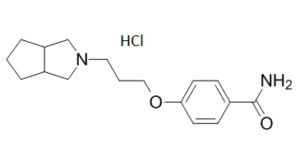This product is for research use only, not for human use. We do not sell to patients.

| Size | Price | Stock |
|---|---|---|
| 5mg | $158 | 3-6 Days |
| 10mg | $235 | 3-6 Days |
| 25mg | $390 | 3-6 Days |
| 50mg | $668 | 3-6 Days |
| 100mg | $1035 | 3-6 Days |
| 250mg | $1655 | 3-6 Days |
| 500mg | $2480 | 3-6 Days |
Cat #: V3823 CAS #: 1222097-72-4 Purity ≥ 98%
Description: S 38093 is a novel brain-penetrant antagonist (inverse agonist) of the H3 (histamine H3) receptor with Ki of 8.8, 1.44 and 1.2 µM for rat, mouse and human H3 receptors, respectively. It may provide an innovative strategy to improve age-associated cognitive deficits. In cellular models, S 38093 is able to antagonize mice H3 receptors (KB=0.65 µM) and to suppress cAMP decrease induced by an H3 agonist via human H3 receptors (KB=0.11 µM). In cells expressing a high H3 density, S 38093 behaves as a moderate inverse agonist at rat and human H3 receptors (EC50=9 and 1.7 µM, respectively). S 38093, as a novel H3 inverse agonist, is a good candidate for further in vivo evaluations, in particular in animal models of cognition.
Publications Citing InvivoChem Products
Product Promise

- Physicochemical and Storage Information
- Protocol
- Related Biological Data
- Stock Solution Preparation
- Quality Control Documentation
| Molecular Weight (MW) | 324.85 |
|---|---|
| Molecular Formula | C17H25ClN2O2 |
| CAS No. | 1222097-72-4 |
| Storage | -20℃ for 3 years in powder form |
| -80℃ for 2 years in solvent | |
| Solubility In Vitro | DMSO: >50 mg/mL |
| Water: N/A | |
| Ethanol: >50 mg/mL | |
| Synonyms | S38093 HCl; S-38093 HCl; S 38093 HCl |
| Protocol | In Vitro | In vitro activity: In cellular models, S 38093 is able to antagonize mice H3 receptors (KB=0.65 µM) and to suppress cAMP decrease induced by an H3 agonist via human H3 receptors (KB=0.11 µM). In cells expressing a high H3 density, S 38093 behaves as a moderate inverse agonist at rat and human H3 receptors (EC50=9 and 1.7 µM, respectively) Kinase Assay: S 38093 is a novel brain-penetrant antagonist (inverse agonist) of the H3 (histamine H3) receptor with Ki of 8.8, 1.44 and 1.2 µM for rat, mouse and human H3 receptors, respectively. Cell Assay: The cells (2 x 106 per ml) were harvested and suspended in Hank's balanced salt solutions/HEPES (pH7.4) buffer containing 1 mM isobutyl-methylxanthine and 1mg/ml of BSA. The fluor 647-anti cAMP antibody solution (1 μl) was added to the cell suspension (100 μl) and 6 μl aliquots of this mix were dispensed in white 384-well microtiter plates. The cells were then incubated with 6 μl aliquots of S 38093 and/or the reference compounds (specific H3 agonist Imetit or antagonist Thioperamide) at increasing concentrations (0.01-100 μM), in the presence of forskolin (FSK, 0.5 μM final concentration) in order to preactivate adenylate cyclase. After a 1 h incubation at room temperature in the dark, the lysis buffer (0.35% Triton X-100, 10mM CaCl2, 50mM HEPES) containing LANCE EU-W8044 labeled streptavidin and biotinyled cAMP was added to the cells. After a 20 h incubation at + 4°C in the dark, plates were read on an microplate reader. |
|---|---|---|
| In Vivo | S 38093, a novel brain-penetrant antagonist/inverse agonist of H3 receptors, on AHN (proliferation, maturation and survival) in 3-month-old and in aged 16-month-old mice. In aged animals, S 38093 induced a reversal of age-dependent effects on hippocampal brain-derived neurotrophic factor (BDNF) BDNF-IX, BDNF-IV and BDNF-I transcripts and increased vascular endothelial growth factor (VEGF) expression. The effects of chronic administration of S 38093 were assessed on a neurogenesis-dependent “context discrimination (CS) test” in aged mice. While ageing altered mouse CS, chronic S 38093 treatment significantly improved CS. Chronic S 38093 treatment increases adult hippocampal neurogenesis and may provide an innovative strategy to improve age-associated cognitive deficits. S 38093 is found to be active at a mean pharmacological dose of 0.3–1 mg/kg p.o./i.p. in animal behavioral tests of working memory (Morris water maze in rats; spontaneous alternation and concurrent serial alternation tests in mice; delayed matching to sample in aged monkeys) and episodic-like memory (social and object recognition tests in rats; contextual discrimination task in mice). S 38093 also improves attention, executive functioning, and cognitive flexibility in MPTP-treated monkeys. Moreover, in line with its H3 antagonist/inverse agonist properties, S 38093 dose-dependently increases extracellular histamine levels in the prefrontal cortex and facilitates cholinergic transmission in the prefrontal cortex and hippocampus of rats after both acute and chronic administrations. S 38093 was rapidly absorbed in mouse and rat (Tmax= 0.25-0.5h), slowly in monkey (2h), with a bioavailability ranging from 20 to 60% and t1/2 ranging from 1.5h to 7.4h. The compound was widely distributed with a moderate volume of distribution and low protein binding. The brain distribution of S 38093 was rapid and high | |
| Animal model | C57Bl/6JRj male mice |
| Solvent volume to be added | Mass (the weight of a compound) | |||
|---|---|---|---|---|
| Mother liquor concentration | 1mg | 5mg | 10mg | 20mg |
| 1mM | 3.0783 mL | 15.3917 mL | 30.7834 mL | 61.5669 mL |
| 5mM | 0.6157 mL | 3.0783 mL | 6.1567 mL | 12.3134 mL |
| 10mM | 0.3078 mL | 1.5392 mL | 3.0783 mL | 6.1567 mL |
| 20mM | 0.1539 mL | 0.7696 mL | 1.5392 mL | 3.0783 mL |
This equation is commonly abbreviated as: C1 V1 = C2 V2
- (1) Please be sure that the solution is clear before the addition of next solvent. Dissolution methods like vortex, ultrasound or warming and heat may be used to aid dissolving.
- (2) Be sure to add the solvent(s) in order.




































